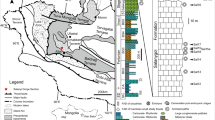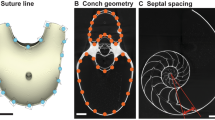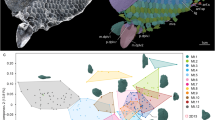Abstract
THE Holothuroidea differ from all other echinoderm classes in having a greatly reduced skeletal system. Typically, external plates are absent, while a peripharyngeal crown, anal plates, madreporite and spicules are usually present. Of these, the endoskeletal spicules (or ossicles), formed in superficial dermal layers, constitute the outstanding character of the class, and are of paramount importance in the specific identification of Recent forms. Although it has been continually stated that such holothurian spicules, as with all other echinoderm skeletal elements, consist entirely of calcium carbonate, few accurate attempts to analyse them chemically have been made1. It seems of interest, therefore, to record results obtained by a chemical examination of spicules from a typical aspidochirote holothuroid, Holothuria impatiens (Forskäl), a littoral species of circumtropical to subtropical distribution.
This is a preview of subscription content, access via your institution
Access options
Subscribe to this journal
Receive 51 print issues and online access
$199.00 per year
only $3.90 per issue
Buy this article
- Purchase on Springer Link
- Instant access to full article PDF
Prices may be subject to local taxes which are calculated during checkout
Similar content being viewed by others
References
Hyman, L. H., “The Invertebrates: Echinodermata”, 138 (McGraw-Hill Pub., New York, 1955).
Horne, J. E. T., Geol. Surv. Great Britain, Bull., 3, 20 (1951).
Orange, M., and Rhein, H. C., J. Biol. Chem., 189, 379 (1951).
Hall, W. T., rev. Treadwell, F. P., “Analytical Chemistry; Quantitative Analysis”, 7th edit., 330 (Wiley, New York, 1930).
Dryer, R. L., Tammes, A. R., and Routh, J. I., J. Biol. Chem., 225, 177 (1957).
Schmidt, W. J., Zool. Jahrb. Anat., 47, 113 (1925).
Mörner, C., Z. physiol. Chem., 37, 86 (1902).
Clarke, F. W., and Wheeler, W. H., U.S. Geol. Surv., Prof. Paper, 102, 55 (1917); ibid., 124, 32 (1922).
Clarke, F. W., and Kamm, R. M., Proc. U.S. Nat. Acad. Sci., 3, 401 (1917).
Frizzell, D. L., and Exline, H., Univ. Miss. Sch. Mines Met., Bull., 89, 9 (1955).
Author information
Authors and Affiliations
Rights and permissions
About this article
Cite this article
HAMPTON, J. Chemical Analysis of Holothurian Sclerites. Nature 181, 1608–1609 (1958). https://doi.org/10.1038/1811608a0
Issue Date:
DOI: https://doi.org/10.1038/1811608a0
Comments
By submitting a comment you agree to abide by our Terms and Community Guidelines. If you find something abusive or that does not comply with our terms or guidelines please flag it as inappropriate.



